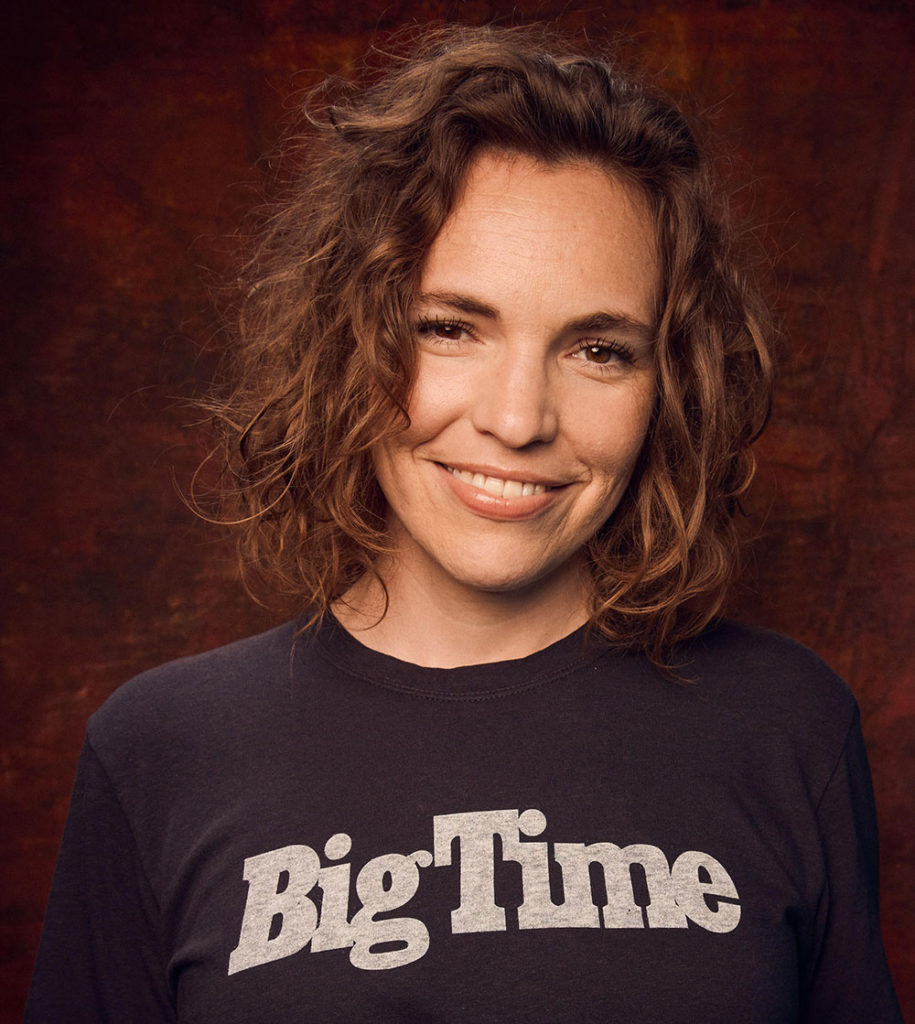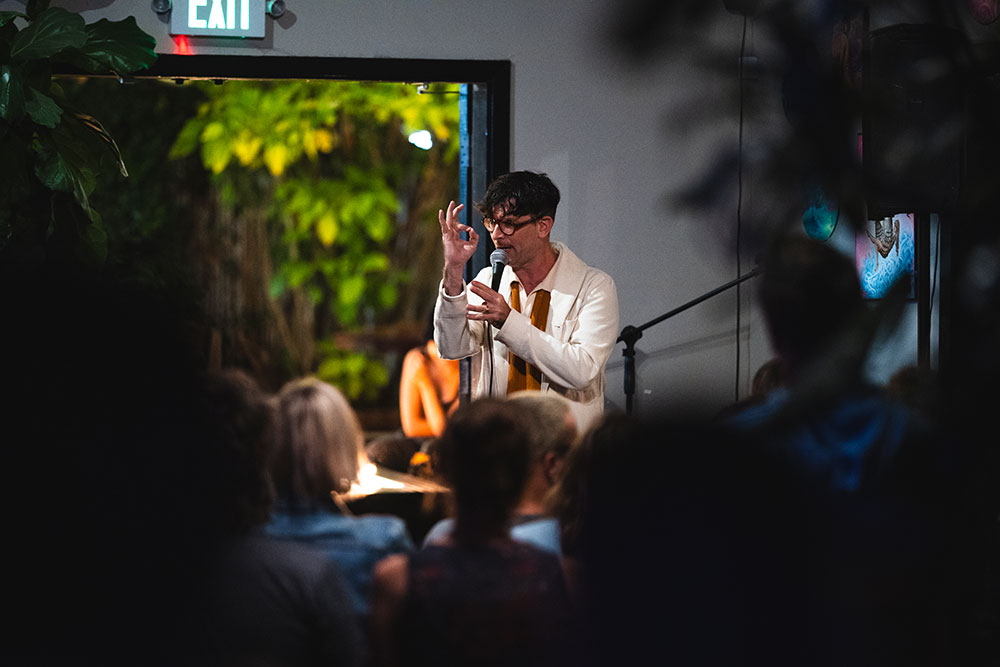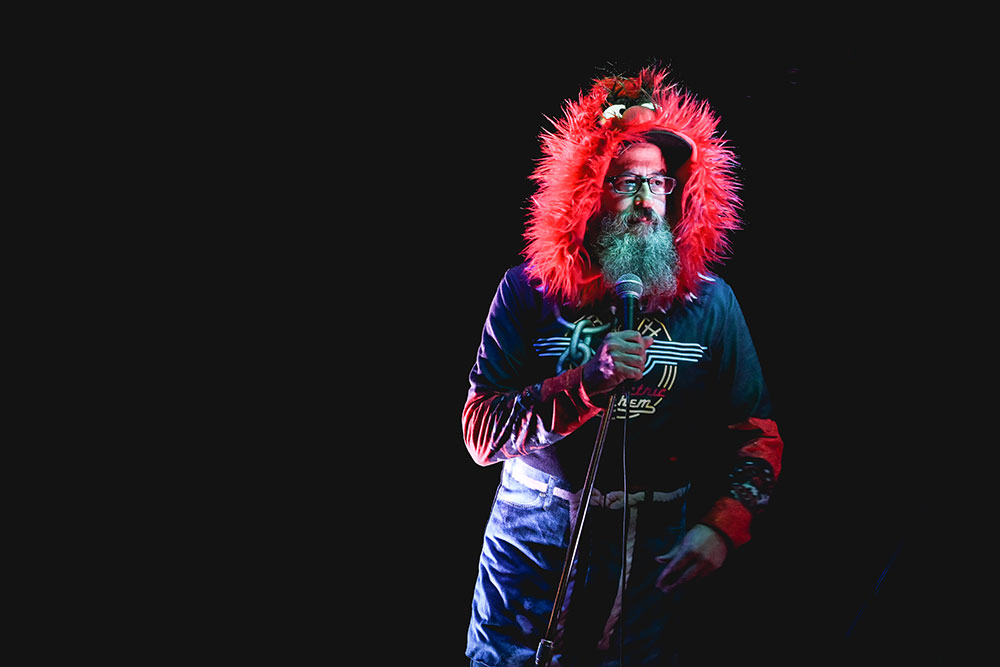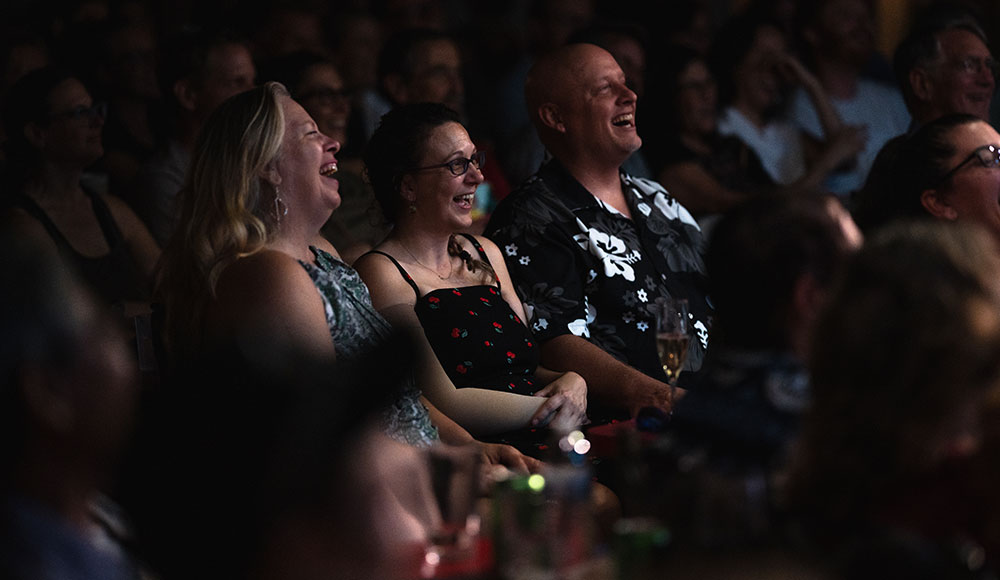Local comedy promoter DNA pens the comedians and their set times on a paper napkin. He hands it to Paulie Escobedo, the sound guy. Everyone gets a tight five minutes save the co-headliners.
Tonight there is a heckler so vocal she creates an anti-gravitational pull on her side of the room.
“You’re a lesbian!” she exclaims to one performer.
Without malice or judgment. Like an entomologist in a field realizing what kind of butterfly they’re studying, then blurting it out to that butterfly.
Welcome to Tuesday night free comedy at the Blue Lagoon.
Michael Booth, slacker beard and hair raked back into a ponytail, jukes the heckler’s drunken jabs. Comedy relies on rhythm, so imagine dropping in off-time syncopation into everyone’s jazz sets.
“My son loves Star Wars!” she says, apropos of nothing.
Booth answers her, fittingly, with a song, belting out a blue cover of the Star Wars theme that the House of Mouse certainly wouldn’t clear, applying perverse lyrics to say explicitly what he’d do to her son in a lightsaber fight.
The rest try to engage her with the classic pretend patience of seasoned comedians, where you smile and dole out enough rope, then BOOM—surprise! The rope was a cobra all along.
But she’s just too gregarious and having too good a time, and every diss just makes her chime back or boil over with laughter. I keep wondering why DNA doesn’t 86 her with extreme prejudice.
No one in the crowd shushes her, but incredulous heads turn. Groups shift to the opposite side of the room.
By the time she and her enabling boyfriend leave midway through the final headliner, a baker’s dozen cocktail glasses in their wake, I understand DNA’s hesitation: what was her side of the room is now a laughter-free zone.
As she leaves, she throws out a surprising zinger: she tells our host that was the best comedy show she’s ever seen.
DNA knows exactly what he’s doing. The 11th annual Santa Cruz Comedy Festival, which runs Oct. 1–5, could not be in better hands.
ALTERNATIVE TENTACLES
Spread across over 15 venues, with local, regional and national comics participating, the Santa Cruz Comedy Festival could be the premier comedy festival experience on the West Coast. Besides the traditional one-person plus one mic, there will be live podcasting, a game show, even an AI vs comics showdown. On closing night, Saturday, Oct. 5, comedians will do four shows in one night. DNA, who ran his self-named Comedy Lab in the old Riverfront Theater, rattles off from memory in his Brick City (New Jersey, to West Coasters) accent the venues they could ricochet between.
“Streetlight [Records], Get Faded Barbershop, Abbott Square, The Abbey, The Church, Woodhouse Blending & Brewing, Rosie McCann’s, Bruno’s in Scotts Valley.”
This year, performers will be chauffeured between shows via bicycle pedicab. He gamed out this potential admin headache by creating a diorama of downtown Santa Cruz using Futurama figurines, timing transit from one venue to the next by riding the route on a non-miniature bicycle himself.
He tried debuting pedicabs last year, but didn’t factor in whom the cab company would assign to the pedals.
“It was a 75-year-old lady.” DNA laughs. “She moved a lot slower than I did.”
Shadowing DNA is like chasing a tornado. Monday he performs in Abbott Square, then Rosie McCann’s, Tuesday he hosts the Blue Lagoon show. We finally slow down in the sunny comfort of his backyard, and he recounts a recent afternoon show he pulled off guerrilla style.
“Would you put any other art form in the back of a beer line with no PA and no stage and no advertising and be like, ‘Do your art’?” he asks.
He has a point. What other artists routinely face such humiliation, either in execution or by design? To err is human, to bomb, divine.
Comedy is chock full of violent slang for bloodless happenings. “Bombing” refers to a doldrums point in a comic’s set when the audience’s laughter ceases or never commences. Barometric pressure falls. Comedians see bombing as a necessary evil on the road to, forget stardom, development. Learning why that joke sparkled in the notebook or Notes app but is loudly “dying” [read: garnering no laughs] in the room. Honing that joke till it “kills” [read: garners all the laughs] both in Poughkeepsie and Portland.

Headliner Beth Stelling, whose current special If You Didn’t Want Me Then was directed by her “Sweethearts” co-podcaster, Mo Welch, says even Portland 7:30 vs Portland 9:30 can differ radically.
“What kills with one crowd may not hit at all the second show,” she says. “It’s a reminder that this job is never steady and ever-changing.”
The comic has choices when momentum stalls: ignore it and trudge on, or steer into the skid, and comment on the audience’s nonparticipation. “That’s too bad, I thought you guys were cool,” one comic responded to the silence during his Abbott Square set.
There is no fourth wall in comedy, maybe no walls at all.
“Comedians are truth-tellers,” DNA says. “They have a long history. The Chinese had jesters. The Romans. The Aztecs. This person in your society who is allowed to tell truth to power. Who is that in 2024? Comedians.”
He thinks in modern times it goes further than mere permission.
“That’s our job.”
Ok Boomer
The job has changed a lot, especially this past decade. The news is filled with older comedians sourly mouthing off that comedy is in a time of intellectual famine. Seinfeld. Chappelle. PC has gone woke, they grouch.
Evaluating cancel culture is a vital topic worth a nuanced discussion. Complaining about it in comedy, though, is pure hack [read: uninspired].
“Is there like a script that these guys get sent and read from?” asks LA-based comedian Amy Miller, the Andy Cohen to Ozzy and the Osbournes on their “Basement Tapes” reunion reality show. Her eyes roll beneath her sunglasses on our long drive to the beach.
The whole thing tires and baffles her. She was starstruck by Martin Lawrence when they shared a bill at The Comedy Store in L.A., but his heroic glow dimmed as soon as he riffed on cancel culture.
“As a comedian, wouldn’t you go, ‘Everyone in my age group is talking about this same tired thing, so I’m not going to say it because I’m a more creative comedian than that’?”
She educates me about the insularity of comedy, how it’s a small community, and a rarefied circle within that where the comedy one percenters live.
“Because they only spend time with other rich, famous comedians, that’s where [they] hear comedy news from. No one has been stopped from saying the things they want to say.”
Jalisa Robinson, who recently performed at “Netflix is a Joke Fest” and is playing the Festival, knows about real censorship.
“I went by Jay for 10 years because, you know, Jalisa was too Black of a name to get jobs in Missouri.”
She agrees with Miller the onus is on the old to adapt, rather than on the young to make accommodations for what the old are accustomed to.
“Be funnier,” she says. “Write better jokes. Do you need to say those words to have good jokes? That’s what I hear: ‘I’m only funny when I’m being offensive.’ I’m like, Well then, you’re not that funny. Sorry. Maybe you got by on that. Maybe you built a whole career on that.”
She winces, utters a sound between ooh and ugh. “That’s done.”
The olds are right that comedy is changing, just not the way they think.
“Comedians mutated,” says DNA, king mutant.
History
DNA began building the skills needed to put on this kind of event back in Chico in the ’90s with a music festival he called Nowhere by Nowhere. Inspired by Austin’s SXSW, 150 bands would migrate from one venue to the next, amps and drums already backlined and waiting.
One major tweak to the format would simplify everything further: “Comedians are a lot easier than bands.”
Moving to Santa Cruz in 2006, he was cautious about “interloper” ambition, gathering allies gradually before launching the first festival—a beautiful disaster—in 2013.
“It was straight out of, like, an [imaginary] Abbie Hoffman book: How to Pose a Major Disturbance for 50 Dollars.”
He rented Steamer Lane and invited three surfing comedians up from L.A. When he arrived to set up, a municipal vehicle was pulling away with all his parking signs. The surfers there had told the city there was no event.
“I’m sure they did, man,” DNA said to the driver.
And so he and the comedians applied their art form to the situation: they improvised.
They turned the PA speakers toward the waves and loosed a firehose of merciless heckling upon the surfers. The LA comedians had the lingo, the right putdowns to penetrate wetsuit-covered flesh. (Curious readers can check out the webseries where this is documented.)
After that stunt-like intro, DNA tried the venue-to-venue format, but with comedians hoofing it, often at their peril. Phil Griffiths, who designs most SCCF artwork, had from 8:10 to 8:30 to sprint from Callahan’s on Water Street all the way to his next venue downtown.
“I didn’t take into consideration their general health,” DNA chuckles.

Griffiths is performing again this year. Several comics have performed multiple years, including Moshe Kasher, whose podcast with his wife, comedian Natasha Leggero, “Endless Honeymoon,” was started on a Santa Cruz stage.
Scotts Valley’s own Emily Catalano, putting up astonishing TikTok numbers for her comedy videos, had her first proper show at the Blue after DNA caught her open mics, then at the well-regarded Greater Purpose (RIP). She found the supportiveness of the Santa Cruz comedy scene its own challenge.
“It made you feel just a little more hopeful about your standup. Even people who aren’t doing comedy will come watch week after week. So you really have to be writing and working out new material. That’s really good for when you’re starting out.”
DNA has given many comedians their first break, as well as their first festival. The comedians I spoke to all agree the point of every festival is connection.
“It’s kind of a summer camp for adult kids talking into microphones,” says Tiff Puterbaugh, one half of the Puterbaugh Sisters, whose glitzy, tipsy Kitchen Women shorts satirize the lives of Eisenhower-era housewives, and which seem like lockdown artifacts but were shot in 2019.
DNA’s favorite SCCF iteration was in 2020. Covid was burning, and so was California. He and his crew built an outdoor stage behind the former Saturn Cafe and Laurie Kilmartin, Dave Ross, Kevin Camia and Merrill Davis performed drive-in comedy as ash sprinkled onto their audience’s windshields.
“There was a feeling of camaraderie between the comics because we hadn’t seen each other for a couple hundred days,” DNA says, “and the people in their cars even though they were a hundred feet away. It was still so good to be with other people for the sole purpose of laughing. To me, that was the pinnacle experience.”
I bring up Emily St. John Mandel’s Station Eleven, about a traveling theater troupe after a flu totals civilization, and he lights up in agreement.
“When the world ends, then what?”
Podcast High & Zoom U
Many comedians were not able to answer that question so confidently when the Ides of March 2020 came.
Some didn’t have access to drive-in comedy the 7th SCCF pulled off, or what local comic Natasha Collier started weekly on top of the Church Street parking structure. Others, like Marc Maron, whose podcast “WTF” was a pandemic life raft for most of the comedians I interviewed, didn’t want to partake. DNA sums up that considerable camp’s feelings.
“‘I’m not gonna do it. That’s not what I worked my whole life for, to be honked at by a car.’”
Kellen Erskine, veteran of multiple late night shows such as Jimmy Kimmel Live!, performed on the top floor of the disorientingly bright Irvine Spectrum Center parking garage, projected onto an 80-foot inflatable screen. He didn’t feel the scenario was insulting as much as a problem of stimuli.
“Your whole life, your brain has been wired to associate honking with something negative, so to tell a joke and just have traffic blast you with their horns?”
For many comedians, the pandemic was about rewiring, a training period for a position no one asked for, or an intense independent study that dragged on semester after semester. They learned how to podcast, film front-facing cellphone videos, how not to “bomb in front of your computer in your bedroom,” Erskine says.
“Comics say you always notice the guy in the second row with his arms folded.” Zoom comedy was that, but supercharged. “It was like having five dozen. When you play a comedy club, if the lighting is good you can’t see most of the audience. But to have people in a grid and you can see all of their faces very clearly or what they’re doing while you’re trying to perform, it’s extremely distracting.”
Robinson tells me how comics would approximate real life as best they could as a grounding technique.
“You’re missing all the environmental things that make you feel like you’re on stage. Some people would have a mic that was unplugged just to have the feel right.”
She says others embraced the medium, even its haunting lag, by discarding the premise-setup-punchline-tag structure, which thrives on interstitial laughter, choosing instead to tell stories, do PowerPoints, even gags like staging a scripted roommate “interruption.”
Stelling, who one comic I interviewed endearingly referred to as “Midwestern Too Nice,” saw nonparticipation in typical indoor comedy shows as an ethical stand, even if it affected rent. She did Matt Rife and Paul Elia’s “Lowkey Outside Comedy” in a flatbed, and a Zoom show where she broadcasted from a studio masked up. Banks, property management companies, every slumlord and robber baron who saw her financials might look at that 2020’s productivity gap when she wasn’t selling specials and ask, “Can you explain this?”
“‘Oh, the pandemic? When I couldn’t tour? I mean, I guess I could explain that: I didn’t want to be one of those comics that killed people?’”
The Puterbaugh Sisters were busy trying to not kill each other.
Chicago comics by way of Ohio, they were used to living together, but not like this.
“Phase One, we did Zoom shows in a blow-up pool in our backyard,” Danielle Puterbaugh recalls. “We were like, ‘This is fun! We’re drinking Truly’s.’ People were Venmo tipping a lot.”
Then the Truly’s went tepid.
Tiff: “We were c*ntier with each other.”
Danielle: “‘You go drink in the yard! I’m drinking in the kitchen.’”
Stelling, whose comedy special was supposed to be HBO Max’s first ever before they pushed it, admits that her streaming services at that time contained some sad data.
“The most fascinating thing is to see how far I got into a comedy special. A lot of times, it’s just this much.” She pinches her fingers together to mimic the time bar. There were exceptions: anything by Maria Bamford, Sarah Silverman.
There’s another reason besides international calamities people can’t finish one-hour comedy specials: interest fatigue.
“Everything is just a blip,” Stelling says.
Lozenges
Big Tech has been training us in divided focus—watching a movie while scrolling our phones; listening to podcasts while map assistants verbally direct us. The pandemic trained us in disengagement.
“It’s certainly no small task to keep people engaged with you for one hour at a live show,” Stelling says.
Now everything comedians make is supposed to be bite-sized, easily digestible. Little comedy lozenges to dissolve at the speed of interest.
Comedians who had created exactly that kind of content out of emotional necessity while sheltering in place, going cuckoo for cocoa puffs just like us, found themselves squeezed by the boa constriction of social media and the general industry machine. Their fans, managers, agents, kingmakers at auditions—everyone expected them to continue churning out that same product.
“It used to be you go on stage and tell your jokes,” DNA says, “but now to be a multimedia performer where you can do videos, editing, every skill you have seems to build a better portfolio, but for what job?”
DNA’s metamorphosis continues. He’s happy to hop up on a picnic table with a borrowed PA to make a venue on the spot, but prides himself on “putting these comedian artists in a space they deserve, which is a stage, with lights, with good sound.”
The question remains, how long can audiences afford to watch?

Laughing Gas Prices
Ticket inflation is rocking the live entertainment industry.
Amy Miller, who worked for a Ticketmaster rival in the mid 2000s, remembers a legitimately competitive ecosystem. Now most of those companies have shuttered, including her former employer.
Any disrupter has to be able to cost-match the giants, and even then, failure is likely. When Louis CK did his experimental cheap tour she and her coworkers watched from the sidelines knowing he couldn’t cleanly subvert the seat-selling infrastructure.
“All-in pricing, no fees. It was a nice gesture, I guess, from a terrible man. But it didn’t work.”
Numerous parties could be guilty of greed, even if corporations might be best at it.
“Comedians and musicians a lot of the time are not engaged enough and they just collect the money at the end so they don’t always know their fans are getting [shafted],” Miller says.
The Puterbaugh Sisters see clubs operating on “old school” money-making principles, including counterproductive ones that practically time-release hecklers.
“There’s no food minimum,” Tiff says. “Why a drink minimum? If you’re a drinker, there’s no such thing as a two-drink minimum. It’s forty-two.” A pricy prospect with rising alcohol prices, but also out of step with Gen Z’s sober curious orientation.
“Will corporate comedy like Live Nation grow to such a Walmart kind of thing that destroys all the mom and pop comedy clubs in America because they don’t have a safety net?” DNA asks. “I can see that happening. In which case I think corporate comedy will set the price. Maybe now a hundred dollars will be the norm for a comedy ticket.”
For the 11th Santa Cruz Comedy Festival, the most you’ll spend is $40 for a “Gold Circle” headliner ticket; the least, free.
DNA sees every year of the festival as another beta test, and at the same time, it’s all one show, and his 17 years of comedy, one long performance.
“It all works. It always works.”
For a complete lineup and tickets, go to www.SantaCruzcomedyfestival.com.












